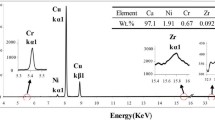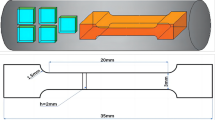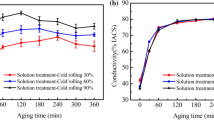Abstract
The effects of 0.1 wt.% Ca addition, heat treatment, and SPD processing using the MaxStrain module of the Gleeble thermomechanical simulator on the microstructure, mechanical properties, and electrical conductivity of Cu–0.7Mg (wt.%) alloy were investigated in this work. The binary alloy exhibited a single-phase microstructure, whereas the ternary alloy featured uniform dispersion of Cu5Ca intermetallic particles inside the grains as well as on grain boundaries. These particles resulted in an average hardness that was 33% higher than that of the binary alloy, as well as 13% higher yield strength and 13% higher ultimate tensile strength. The heat treatment process not only enhanced the yield strength and ultimate tensile strength of the samples, but also resulted in the partial spheroidization of Cu5Ca particles within the microstructure of the ternary alloy, resulting in its improved ductility. Following MaxStrain processing, ternary samples exhibited a smaller grain size and a higher fraction of high-angle grain boundaries than binary samples, which was attributed to the vital role of Cu5Ca intermetallic particles in hindering the dislocation motion during deformation. MaxStrain-processed samples exhibited marginally lower electrical conductivities than their initial counterparts; yet, all MaxStrain-processed samples satisfied the electrical conductivity threshold for classification as HSHC Cu alloys.

















Similar content being viewed by others
Data availability
The raw/processed data required to reproduce the above findings cannot be shared at this time as the data also forms part of an ongoing study.
References
Li B, Lin D, Zhang X, Zhao D, He C, Zhao N. Exceptional dynamic compressive properties of bio-inspired three-dimensional interlocking graphene network reinforced copper matrix composites. Compos Part A Appl Sci Manuf. 2024;176: 107856. https://doi.org/10.1016/j.compositesa.2023.107856.
Tang S, Zhou M, Zhang Y, Xu D, Zhang Z, Zheng X, Li D, Li X, Tian B, Jia Y, Liu Y, Volinsky AA, Marchenko ES. Improved microstructure, mechanical properties and electrical conductivity of the Cu–Ni–Sn–Ti–Cr alloy due to Ce micro-addition. Mater Sci Eng A. 2023;871: 144910. https://doi.org/10.1016/j.msea.2023.144910.
Yang H, Ma Z, Lei C, Meng L, Fang Y, Liu J, Wang H. High strength and high conductivity Cu alloys: a review. Sci China Technol Sci. 2020;63:2505–17. https://doi.org/10.1007/s11431-020-1633-8.
Tang X, Chen X, Sun F, Liu P, Zhou H, Fu S. The current state of CuCrZr and CuCrNb alloys manufactured by additive manufacturing: a review. Mater Des. 2022;224: 111419. https://doi.org/10.1016/j.matdes.2022.111419.
Maki K, Ito Y, Matsunaga H, Mori H. Solid-solution copper alloys with high strength and high electrical conductivity. Scr Mater. 2013;68:777–80. https://doi.org/10.1016/j.scriptamat.2012.12.027.
Jiang Y, Zhang X, Cai P, Li P, Cao F, Gao F, Liang S. Precipitation behavior and microstructural evolution during thermo-mechanical processing of precipitation hardened Cu–Hf based alloys. Acta Mater. 2023;245: 118659. https://doi.org/10.1016/j.actamat.2022.118659.
Wang C, Fu H, Zhang H, He X, Xie J. Simultaneous enhancement of mechanical and electrical properties of Cu–Ni–Si alloys via thermo-mechanical process. Mater Sci Eng A. 2022;838: 142815. https://doi.org/10.1016/j.msea.2022.142815.
Wei KX, Chu ZQ, Wei W, Du QB, Alexandrov IV, Hu J. Effect of deep cryogenic treatment on microstructure and properties of pure copper processed by equal channel angular pressing. Adv Eng Mater. 2019;21:1801372. https://doi.org/10.1002/adem.201801372.
Yang K, Wang Y, Guo M, Wang H, Mo Y, Dong X, Lou H. Recent development of advanced precipitation-strengthened Cu alloys with high strength and conductivity: a review. Prog Mater Sci. 2023. https://doi.org/10.1016/j.pmatsci.2023.101141.
Lai Z, Peng K, Gao B, Mai Y, Jie X. Achieving high strength and high electrical conductivity in Cu–Cr–Zr alloy by modifying shear banding during rolling. J Alloys Compd. 2023;958: 170402. https://doi.org/10.1016/j.jallcom.2023.170402.
Ma M, Li Z, Qiu W, Xiao Z, Zhao Z, Jiang Y, Xia Z, Huang H. Development of homogeneity in a Cu–Mg–Ca alloy processed by equal channel angular pressing. J Alloys Compd. 2020;820: 153112. https://doi.org/10.1016/j.jallcom.2019.153112.
Zhu C, Ma A, Jiang J, Li X, Song D, Yang D, Yuan Y, Chen J. Effect of ECAP combined cold working on mechanical properties and electrical conductivity of Conform-produced Cu–Mg alloys. J Alloys Compd. 2014;582:135–40. https://doi.org/10.1016/j.jallcom.2013.08.007.
Mezbahul-Islam M, Mostafa A, Medraj M. Essential magnesium alloys binary phase diagrams and their thermochemical data. J Mater. 2014. https://doi.org/10.1155/2014/704283.
Gorsse S, Ouvrard B, Gouné M, Poulon-Quintin A. Microstructural design of new high conductivity–high strength Cu-based alloy. J Alloys Compd. 2015;633:42–7. https://doi.org/10.1016/j.jallcom.2015.01.234.
Ma A, Zhu C, Chen J, Jiang J, Song D, Ni S, He Q. Grain refinement and high-performance of equal-channel angular pressed Cu–Mg alloy for electrical contact wire. Metals (Basel). 2014;4:586–96. https://doi.org/10.3390/met4040586.
Rodríguez-Calvillo P, Ferrer N, Cabrera JM. Analysis of microstructure and strengthening in CuMg alloys deformed by equal channel angular pressing. J Alloys Compd. 2015;626:340–8. https://doi.org/10.1016/j.jallcom.2014.12.043.
Ma M, Zhang X, Li Z, Xiao Z, Jiang H, Xia Z, Huang H. Effect of equal channel angular pressing on microstructure and mechanical properties of a Cu–Mg alloy. Crystals. 2020. https://doi.org/10.3390/cryst10060426.
Bodyakova A, Tkachev M, Pilipenko A, Belyakov A, Kaibyshev R. Effect of deformation methods on microstructure, texture, and properties of a Cu–Mg alloy. Mater Sci Eng A. 2023;876: 145126. https://doi.org/10.1016/j.msea.2023.145126.
Li Y, Xiao Z, Li Z, Zhou Z, Yang Z, Lei Q. Microstructure and properties of a novel Cu–Mg–Ca alloy with high strength and high electrical conductivity. J Alloys Compd. 2017;723:1162–70. https://doi.org/10.1016/j.jallcom.2017.06.155.
Wang B, Zhang Y, Tian B, Yakubov V, An J, Volinsky AA, Liu Y, Song K, Li L, Fu M. Effects of Ce and Y addition on microstructure evolution and precipitation of Cu–Mg alloy hot deformation. J Alloys Compd. 2019;781:118–30. https://doi.org/10.1016/j.jallcom.2018.12.022.
Wang B, Zhang Y, Tian B, An J, Volinsky AA, Sun H, Liu Y, Song K. Effects of Ce addition on the Cu–Mg–Fe alloy hot deformation behavior. Vacuum. 2018;155:594–603. https://doi.org/10.1016/j.vacuum.2018.06.006.
Chakrabarti DJ, Laughlin DE. The Ca−Cu (Calcium-Copper) system. Bull Alloy Phase Diagrams. 1984;5:570–6. https://doi.org/10.1007/BF02868318.
Risold D, Hallstedt B, Gauckler LJ, Lukas HL, Fries SG. Thermodynamic optimization of the Ca-Cu and Sr-Cu systems. Calphad. 1996;20:151–60. https://doi.org/10.1016/S0364-5916(96)00022-3.
Ma M, Li Z, Qiu W, Xiao Z, Zhao Z, Jiang Y. Microstructure and properties of Cu–Mg-Ca alloy processed by equal channel angular pressing. J Alloys Compd. 2019;788:50–60. https://doi.org/10.1016/j.jallcom.2019.01.335.
Chen Y, Xie J, Cao W. Research on friction stir welded joints of copper to magnesium alloy BT. In: Proceedings of the international symposium on mechanical engineering and material science. Amsterdam: Atlantis Press; 2016. p. 310–5. https://doi.org/10.2991/ismems-16.2016.53.
Svyetlichnyy DS, Majta J, Kuziak R, Muszka K. Experimental and modelling study of the grain refinement of Fe-30wt%Ni-Nb austenite model alloy subjected to severe plastic deformation process. Arch Civ Mech Eng. 2021;21:20. https://doi.org/10.1007/s43452-021-00178-7.
Petryk H, Stupkiewicz S, Kuziak R. Grain refinement and strain hardening in IF steel during multi-axis compression: experiment and modelling. J Mater Process Technol. 2008;204:255–63. https://doi.org/10.1016/j.jmatprotec.2007.11.068.
Zygmuntowicz J, Wiecińska P, Wachowski M, Kurek M, Kaszuwara W. Thermogravimetric analysis coupled with mass spectrometry of ceramic–metal ternary composites Al2O3–Cu–Mo. Measurement. 2023;217: 113049. https://doi.org/10.1016/j.measurement.2023.113049.
Mandal P, Mondal SC. Investigation of electro-thermal property for Cu-MWCNT composite coating on anodized 6061 aluminium alloy. Appl Surf Sci. 2018;454:138–47. https://doi.org/10.1016/j.apsusc.2018.05.130.
Henle R, Dölling J, Prahl U, Nandi G, Zilly A. DSC Analysis of the effect of cold deformation on the precipitation kinetics of a binary Cu–Sc alloy. Materials (Basel). 2023. https://doi.org/10.3390/ma16093462.
Rakoczy Ł, Grudzień-Rakoczy M, Cygan R, Rutkowski B, Kargul T, Dudziak T, Rząd E, Milkovič O, Zielińska-Lipiec A. Characterization of the as-cast microstructure and selected properties of the X-40 Co-based superalloy produced via lost-wax casting. Arch Civ Mech Eng. 2022;22:143. https://doi.org/10.1007/s43452-022-00466-w.
Xu D, Zhou M, Zhang Y, Tang S, Zhang Z, Liu Y, Tian B, Li X, Jia Y, Volinsky AA, Li D, Liu Q. Microstructure and hot deformation behavior of the Cu–Sn–Ni–Zn–Ti(-Y) alloy. Mater Charact. 2023;196: 112559. https://doi.org/10.1016/j.matchar.2022.112559.
Zhang Y, Liu P, Tian B, Liu Y, Li R, Xu Q. Hot deformation behavior and processing map of Cu–Ni–Si–P alloy. Trans Nonferrous Met Soc China. 2013;23:2341–7. https://doi.org/10.1016/S1003-6326(13)62739-9.
Field DP, Bradford LT, Nowell MM, Lillo TM. The role of annealing twins during recrystallization of Cu. Acta Mater. 2007;55:4233–41. https://doi.org/10.1016/j.actamat.2007.03.021.
Wang H, Yin D, Zhao M-C, Tian Y, Atrens A. The hot deformation characteristics and the associated microstructural evolution of an Al–Cu–Li–Zn alloy studied by constitutive equations and processing maps. J Mater Res Technol. 2023;27:401–18. https://doi.org/10.1016/j.jmrt.2023.09.222.
Zhang H, Zhang K, Zhou H, Lu Z, Zhao C, Yang X. Effect of strain rate on microstructure evolution of a nickel-based superalloy during hot deformation. Mater Des. 2015;80:51–62. https://doi.org/10.1016/j.matdes.2015.05.004.
Lapeire L, Sidor J, Verleysen P, Verbeken K, De Graeve I, Terryn H, Kestens LAI. Texture comparison between room temperature rolled and cryogenically rolled pure copper. Acta Mater. 2015;95:224–35. https://doi.org/10.1016/j.actamat.2015.05.035.
Muñoz JA, Khelfa T, Gheorghe D, Higuera OF, Rodriguez P, Cabrera JM. Microstructure characterization of metallic materials processed by equal channel angular pressing (ECAP): an electron backscatter diffraction (EBSD) analysis. Mater Trans. 2023. https://doi.org/10.2320/matertrans.MT-MF2022042.
Chen Y, Cheng M, Song H, Zhang S, Liu J, Zhu Y. Effects of lanthanum addition on microstructure and mechanical properties of as-cast pure copper. J Rare Earths. 2014;32:1056–63. https://doi.org/10.1016/S1002-0721(14)60183-6.
Sun X, Ebrahimi M, Attarilar S. The decisive impact of microstructure on the machinability of pure copper. Arch Civ Mech Eng. 2021;21:136. https://doi.org/10.1007/s43452-021-00290-8.
Higuera-Cobos OF, Cabrera JM. Mechanical, microstructural and electrical evolution of commercially pure copper processed by equal channel angular extrusion. Mater Sci Eng A. 2013;571:103–14. https://doi.org/10.1016/j.msea.2013.01.076.
Acknowledgements
This work has been financially supported by the Silesian University of Technology through project No. 11/030/BK_23/1127 and VŠB—Technical University of Ostrava through Project No. CZ.02.1.01/0.0/0.0/17_049/0008399. The authors also gratefully acknowledge the valuable collaboration and technical support provided by the members of the Faculty of Materials Engineering at the Silesian University of Technology, without which this investigation would not have been possible.
Author information
Authors and Affiliations
Contributions
Alireza Kalhor: data curation; formal analysis; investigation; methodology; resources; software; validation; visualization; writing—original draft; writing—review and editing. Kinga Rodak: conceptualization; formal analysis; funding acquisition; investigation; methodology; project administration; resources; supervision; validation; visualization; writing—review and editing. Marek Tkocz: conceptualization; investigation; software. Hanna Myalska-Głowacka: data curation; investigation. Ivo Schindler: data curation; funding acquisition. Łukasz Poloczek: data curation. Krzysztof Radwański: data curation; investigation. Hamed Mirzadeh: writing—review and editing. Michał Grzenik: data curation. Krzysztof Kubiczek: data curation. Marian Kampik: data curation.
Corresponding author
Ethics declarations
Conflict of interest
The authors declare that they have no known competing financial interests or personal relationships that could have appeared to influence the work reported in this paper.
Declaration of generative AI and AI-assisted technologies in the writing process
During the preparation of this work, the authors used ChatGPT-3.5 in order to detect and correct any grammatical mistakes. After using this tool, the authors reviewed and edited the content as needed and take full responsibility for the content of the publication.
Ethical statement
The manuscript has been prepared with the contributions of all authors; it is an original work; it has not been published before; it has been solely submitted to this journal; and if accepted, it will not be submitted to any other journal in any language.
Additional information
Publisher's Note
Springer Nature remains neutral with regard to jurisdictional claims in published maps and institutional affiliations.
Rights and permissions
Springer Nature or its licensor (e.g. a society or other partner) holds exclusive rights to this article under a publishing agreement with the author(s) or other rightsholder(s); author self-archiving of the accepted manuscript version of this article is solely governed by the terms of such publishing agreement and applicable law.
About this article
Cite this article
Kalhor, A., Rodak, K., Tkocz, M. et al. Tailoring the microstructure, mechanical properties, and electrical conductivity of Cu–0.7Mg alloy via Ca addition, heat treatment, and severe plastic deformation. Archiv.Civ.Mech.Eng 24, 71 (2024). https://doi.org/10.1007/s43452-024-00890-0
Received:
Revised:
Accepted:
Published:
DOI: https://doi.org/10.1007/s43452-024-00890-0




